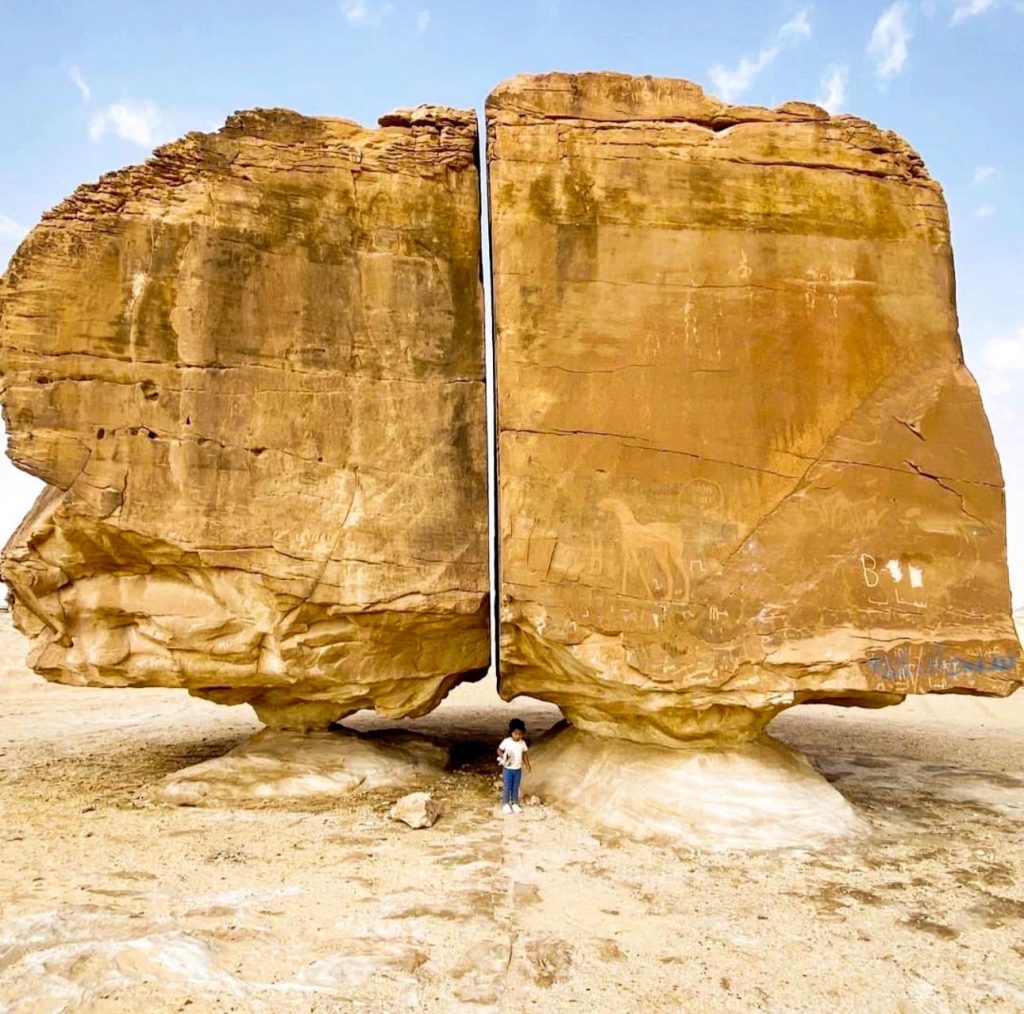Al Naslaa, an extraordinary natural rock formation near Tayma in Saudi Arabia, showcases the incredible power of nature’s artistry. This geological marvel features two massive sandstone blocks divided by an almost perfectly straight vertical slit, standing delicately balanced on a naturally-formed pedestal. The formation leaves visitors awestruck, not only because of its striking appearance but also due to the enduring mystery of how this split came to be. While its exact cause remains uncertain, experts suggest that a combination of environmental factors—including wind-driven sand, seasonal rains, and subtle movements within the underlying rock—likely contributed to this unique spectacle.
An Adventurous Journey to Al Naslaa
Getting to Al Naslaa is an adventure in itself, requiring an off-road trek through the sandy terrain surrounding Tayma. Travelers often rely on four-wheel drive vehicles to navigate the rugged path safely, turning the journey into an exhilarating expedition. While the trip may pose challenges, the sight that awaits is more than worth the effort. Upon arrival, visitors are greeted by the breathtaking view of the Al Naslaa formation, which is adorned with intricate petroglyphs that offer a glimpse into ancient Arabian culture.

A Window into Early Arabian Culture: The Rich Petroglyphs of Al Naslaa
Examining the smooth, flat surfaces of Al Naslaa reveals a treasure trove of ancient petroglyphs, each offering insights into life in early Arabia. These carvings depict various scenes, with one particularly striking tableau showing a man leading a horse. Surrounding this central figure are images of camels and tribal symbols, known as Wasums. These detailed carvings shed light on the early domestication and care of Arabian horses, reflecting the profound connection between the people of the region and these noble animals.
The Magnificent Arabian Horse: A Symbol of Ancient Artistry
A standout feature on the right side of the formation is a panel showcasing a magnificent Arabian horse rendered in the traditional North Arabian style. The carving captures intricate details, such as the horse’s halter, prominent forelock, and full tail, demonstrating the artistic skill of its creator. The depiction also includes a man holding the horse’s lead with one hand while grasping an arrow in the other. The shading etched into the horse’s body suggests a solid, natural coloration, adding to the realism of the piece.
The man in the carving is depicted wearing a futah, a cloth wrap traditionally used to cover the lower body. This scene not only showcases the artistry of the time but also provides valuable insights into the training and handling techniques employed for Arabian horses. The man’s firm grip on the lead reflects the skill required to maintain the horse’s head in the correct position, emphasizing control and discipline. Additionally, the raised arrow positioned in front of the horse’s face is believed to have served as a training tool, directing the animal’s focus and attention during their interactions.
Al Naslaa Rock: A Timeless Merge of Nature and Culture
Al Naslaa stands as a stunning testament to the interplay between the forces of nature and the rich cultural heritage of the Arabian Peninsula. The flawless vertical slit that divides the formation has sparked fascination and debate among geologists and historians alike. Some propose that natural erosion caused by wind and water over thousands of years could explain the precise split, while others believe tectonic activity or ancient human intervention may have played a role. Regardless of its origin, the formation’s delicate balance on its pedestal and the mysterious precision of its split make it a captivating sight.
A Hidden Gem Worth Exploring
Beyond its geological allure, Al Naslaa offers a profound connection to the past. The petroglyphs etched into its surface provide a visual narrative of the people who once inhabited this region. These ancient carvings reflect not only their daily lives but also their deep respect for the animals that were integral to their survival and culture. The depiction of Arabian horses—symbols of strength, loyalty, and beauty—highlights their significance in both practical and symbolic contexts.
The Legacy of Arabian Horses in History
The Arabian horse, long celebrated for its elegance and endurance, holds a special place in the history of the region. The carvings at Al Naslaa emphasize the importance of these animals in ancient Arabian society, where they were not only used for transportation and warfare but also revered as companions and symbols of status. The intricate details in the carvings suggest that the artists were keen observers, capturing the essence of these majestic creatures with remarkable accuracy.
Preserving the Beauty of Al Naslaa
As an enduring symbol of nature’s grandeur and human ingenuity, Al Naslaa continues to captivate visitors from around the world. Efforts to preserve this natural wonder are essential to ensure that future generations can appreciate its beauty and cultural significance. Responsible tourism, coupled with initiatives to protect the surrounding environment, will play a crucial role in safeguarding this remarkable site.
A Journey Through Time and Nature
Visiting Al Naslaa is not just a trip to a geological marvel; it is a journey through time. The rock formation stands as a silent witness to centuries of history, offering a unique glimpse into the lives, artistry, and ingenuity of ancient Arabian cultures. Whether viewed as a natural wonder or a cultural treasure, Al Naslaa remains an awe-inspiring destination that continues to inspire and intrigue all who encounter it.





